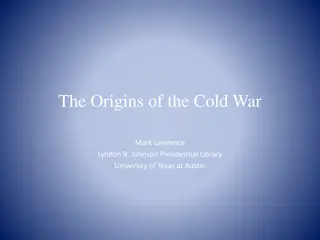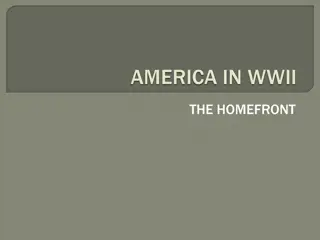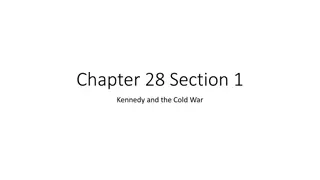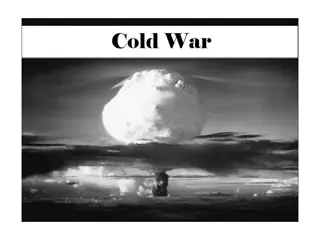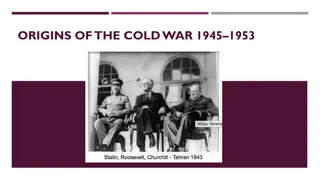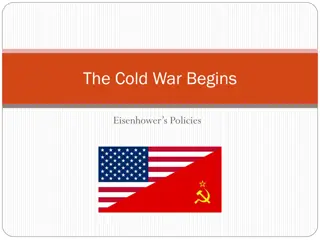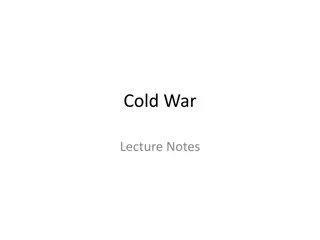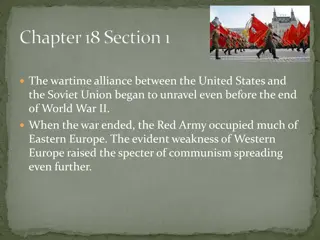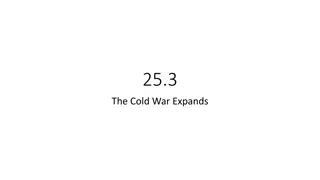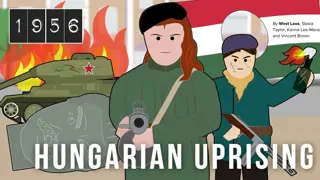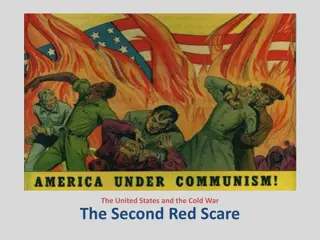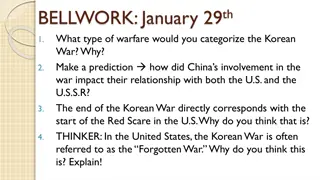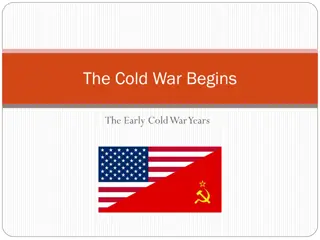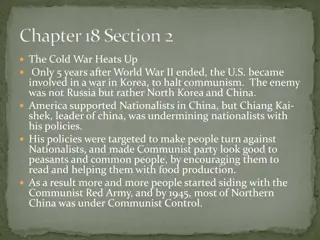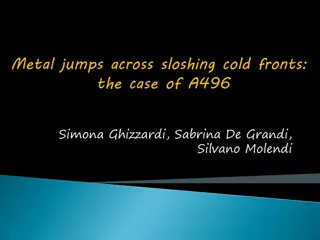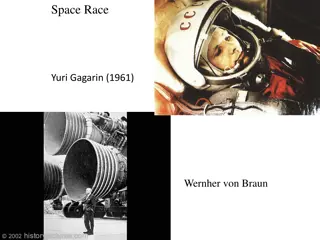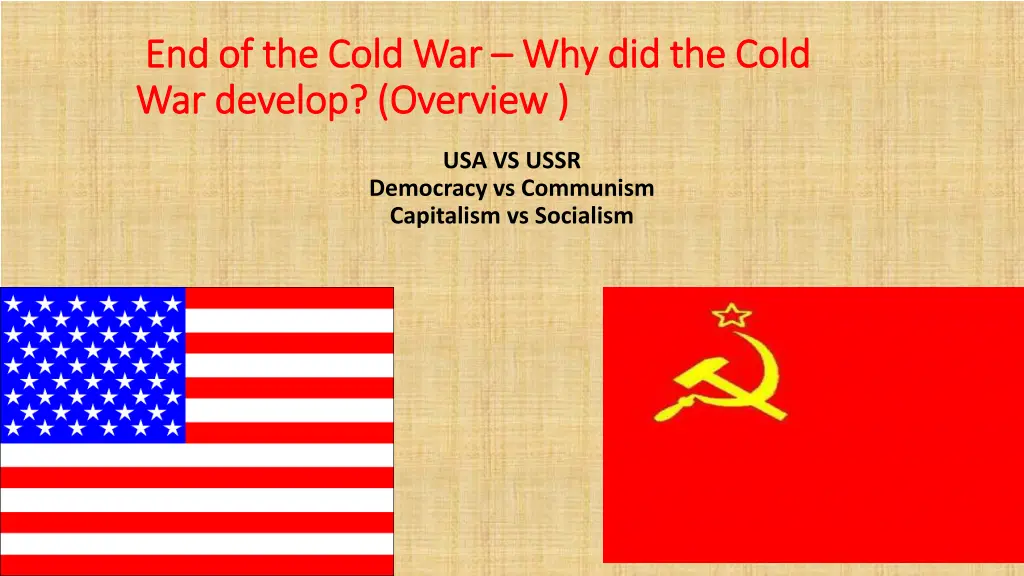
Understanding the Development and End of the Cold War
Explore the origins and culmination of the Cold War between the USA and USSR, stemming from political, strategic, and ideological struggles post-World War II. Discover how mistrust, suspicions, and conflicting ideologies led to the competitive nature of the Cold War and its ultimate resolution.
Download Presentation

Please find below an Image/Link to download the presentation.
The content on the website is provided AS IS for your information and personal use only. It may not be sold, licensed, or shared on other websites without obtaining consent from the author. If you encounter any issues during the download, it is possible that the publisher has removed the file from their server.
You are allowed to download the files provided on this website for personal or commercial use, subject to the condition that they are used lawfully. All files are the property of their respective owners.
The content on the website is provided AS IS for your information and personal use only. It may not be sold, licensed, or shared on other websites without obtaining consent from the author.
E N D
Presentation Transcript
End of the Cold War End of the Cold War Why did the Cold War develop? (Overview ) War develop? (Overview ) Why did the Cold USA VS USSR Democracy vs Communism Capitalism vs Socialism
Political, Strategic and Ideological struggle between the USA and USSR- Spreading through the whole world. COLD WAR COLD WAR - - Characteristics Characteristics Struggle nearly developed into a war Competitive Social and Economical ideologies
End of the Second World War: Why did a Cold War End of the Second World War: Why did a Cold War develop? develop? Winston Churchill (GB), Franklin Roosevelt (VSA) and Joseph Stalin (USSR) at Yalta for the meeting to discuss the future of post war Germany. Mistrust between the West and the USSR Suspicions and tensions increased During WW2 the USA, USSR and BRTAIN formed a GRAND ALLIANCE reason to defeat Germany Uneasy Alliance
Main Purpose: To decide what to do about Germany and the countries controlled by the Germans in Eastern Europe once the Nazi had been defeated in the war? Agreement: Germany would be divided into 4 zones Zones of Occupation: administered by one of the Big Three Allied Powers Agreed that the countries in Eastern Europe should be allowed to hold free elections Yalta Yalta Conference Conference (1945) (1945)
Germany was defeated in May 1945 between the USSR and the WEST Second conference of Allied leaders held at Potsdam Potsdam Conference Soviet Army was in control of Eastern Europe Communist government in Poland Roosevelt had died replaced by Truman (much more anti-communist - suspicious of Stalin) The Potsdam The Potsdam conference conference (July (July- -August August 1945) 1945)
USA developed and tested the first atomic bomb - Americans did not inform Stalin More mistrust Churchill defeated in a general election replaced by Attlee (new Labour Prime minister) Suspicion between Stalin and Truman dominated the conference Key Area of disagreement: what to do about Germany The Potsdam The Potsdam conference conference (July (July- -August August 1945) 1945)
Occupation of Germany Germany divided into four zones of occupation Soviet Union would administer the Eastern Zone USA, BRITAIN AND FRANCE would administer the Western zones The city of Berlin would also be divided into four sectors They agreed that Germany remain united and that economically they should work in co-operation with the long term goal of keeping Germany one country
Both superpowers tried to strengthen their control over parts of Europe The USSR in Eastern Europe and the USA in Western Europe The USSR annexed the eastern part of Poland USSR ensured that Soviet-friendly governments came to power in Poland, Hungary, Bulgaria, Romania and East Germany These countries became known as Soviet Satellites Presence of the Soviet Army ensured Soviet friendly governments came to power The free elections, which the USSR had agreed at Yalta did not take place A communist coup (violent change in government) in Czechoslovakia seemed to confirm Western suspicions that the USSR was trying to extend its control and influence The USSR The USSR and the USA and the USA the the creation of creation of spheres of spheres of influence influence
Soviet Soviet friendly governments friendly governments in the satellite states in the satellite states USA and BRITAIN worried That communist governments would take control in the rest of Europe E.g. Greece, Italy and France Iron-curtain speech by Churchill Dividing Europe into East and West
Concerns about the extension of Soviet control led to a radical change in American foreign policy USA believed that the USSR wanted to establish communist government throughout Europe and in other parts of the world USA did not return to its traditional policy of isolation Became actively involved in world affairs USA adopted a policy of containment: to contain or check the spread of communism The USA s The USA s Policy of Policy of Containment: Containment: the Truman the Truman Doctrine and Doctrine and the Marshall the Marshall Plan Plan
Reasons: Civil war in Greece broke out between: communist-led guerrillas and the Greek government In Turkey a similar situation had developed USA believed that in both cases the USSR supported communism President Truman announced the change in policy USA- prepared to send money, military equipment and advice to any country that was threatened by a communist takeover The Truman Doctrine became the basis of American policy during the Cold War USA sent aid to Greek and Turkish governments-this helped them to defeat the communist guerrillas The Truman The Truman Doctrine Doctrine
Policy of containment-prevent spread of communism USA secretary of State: George Marshall He investigated the post war economic situation in Europe He reported much of Europe destroyed - people were suffering USA decided on economic aid Aim to rebuild the post- war European economies Between 1948 and 1952 the USA gave $17 billion of Marshall aid Help them to rebuild their economies Purpose: to help bring about a remarkable economic recovery It was successful The Marshall The Marshall Plan Plan
Stalin suspicious of the aims behind the Marshall Plan saw it as a form of dollar diplomacy He would not allow any of the Soviet satellites to accept the Marshall Plan Marshall-plan increased the divisions between Eastern and Western Europe Stalin set up Cominform to co-ordinate communist parties of Eastern Europe Independent minded leaders were replaced by those who were loyal to Stalin Comecon (Council for Mutual Economic Aid) formed in 1949 The Soviet The Soviet Response to Response to the Marshall the Marshall plan plan
Differences over management of Germany caused the first crisis of the Cold War Berlin Capital of Germany which lay deep within the Soviet zone Different political and economic systems in the different German zones Soviet zone: a communist dictatorship was established - Nationalising of Industries Economic recovery slow was instructed not to accept American Aid USSR forced East Germans to pay reparations Reichsmark as their currency The Berlin The Berlin Crisis (1940 Crisis (1940- - 1961) 1961)
Western Western Zones Zones: : Different political parties formed Local Democratic elections held Free Enterprise were encouraged Rapid economic recovery began helped by Marshall Plan 1948 Western Zones had united New currency (Deutsche mark)
1948-49: The Berlin Blockade and Airlift
The West did not want to force the USSR to lift the blockade, hoping to avoid war in this way. USSR sees Western decision as a weakness in leadership Western decision on the establishment of the Berlin Airlift For nearly a year the West supplied the Western sectors of Berlin with Food, fuel, building material In 1949 Stalin called off the Blockade the tension between the superpowers increases the superpowers Berlin became a symbol of Cold War tensions
Western Zones: Became the German Federal Republic (West Germany) Capital - Bonn Leader: Konrad Adenauer Germany divided into two separate states Soviet Zone: Became the German Democratic Republic (East Germany) Capital: East-Berlin Leader: Walter Ulbricht Germany was to remain divided for the next 40 years
Protests by workers in East Berlin Spread Throughout East Germany Workers demanded: End of Communism Withdrawal of Soviet forces Uprisings crushed by Soviet Army 500 East Germans were executed 300 000 East Germans fled to the West The East German government introduced some reforms 1953: 1953: Uprisings in Uprisings in East Berlin East Berlin
1958 the new Soviet leader, Nikita Khrushchev, demanded that the West hand over Berlin to East Germany West ignored this demand In 1960 Khrushchev and President Eisenhower (USA) planned to meet in Paris to discuss the future of Berlin USSR cancelled the meeting when an American Spy Plane was shot down while it was flying over the USSR The plane had been photographing military installations Americans were forced to admit their involvement Eisenhower refused to apologise for the incident Khrushchev stormed out of the Paris meeting Many people criticised Eisenhower actions as irresponsible The incident increased the tensions between the superpowers (USSR and USA) 1958 1958- -60: Further Further tensions over tensions over Berlin Berlin The U2 Spy Plane U2 Spy Plane incident incident 60: The
In 1961 Berlin again became the focus of attention 10 000 people a week were leaving Reason: leaving for the higher standard of living and greater freedom which the West offered USSR wanted to stop the loss of people, and the skills they took with them to the West by leaving through Berlin August 1961, East German authorities built a wall to divide East and West Berlin Cutting the city in half overnight This high, fortified Berlin Wall with its machine gun posts and searchlights, stopped the flow of refugees The West was powerless to prevent the building of the Wall 1961: The Building of the Berlin Wall
West Berlin was an island of Capitalism and Democracy surrounded by East Germany Many East Germans died trying to escape across the Wall The Wall became a Famous Symbol of the Cold War period
Tension between the Superpowers led to the creation of two military alliances Opposing Opposing Military Military Alliances Alliances USA and Western European Allies: formed the North Atlantic Treaty Organisation (NATO) The USSR and its Allies: formed the Warsaw Treaty Organisation (Warsaw Pact)
USA concerned that the USSR wanted communist control over Western Europe Military strength of the Soviet Union was much greater than the combined strength of the armed forces of Western Europe USA decided to form a military alliance with its western European Allies US forces in readiness in case of a Soviet attack NATO formed headquarters in Paris USA provided most of the forces and weapons Set up military bases in Britain, Spain, Italy, Greece and Turkey 1949: The 1949: The Formation of Formation of NATO NATO
The West viewed NATO as a form of protection against the spread of communism The USSR saw it as another attempt by the USA to increase its influence in Europe Both superpowers were determined to maintain their spheres of influence in Europe France challenged the US domination of western Europe President Gaulle withdrew French forces from NATO wanted France to have its own nuclear weapons programme and a more independent foreign policy NATO headquarters moved from Paris to Brussels in Belgium
The West allow West Germany to join NATO in 1955 USSR feared that this could lead to the growth of militarism in Germany Soviet troops remained in most Warsaw Pact countries. West saw the Warsaw Pact as a means by which the Soviet Union could maintain its control over Eastern Europe Some Warsaw Pact members threatened to withdraw e.g.. Hungary USSR used its army to crush the uprisings in Hungary Czech people rose up in revolt against Soviet domination Soviet government announced the Brezhnev Doctrine(Soviet foreign policy , giving the USSR the right to intervene in the satellite states) 1955: The 1955: The formation of formation of the Warsaw the Warsaw Pact Pact
The competition between the superpowers was not confined to political control and military alliances ARMS RACE Technology and science played an important role in the production of weapons A Deadly Arms Race Developed By the 1960 s , both sides had enough weapons to destroy each other Each hoped that knowing this would be enough to stop the other side from attacking first Competition Competition between the between the opposing opposing Military Military Alliances Alliances
MAD: Mutually Assured Destruction people around the world lived in fear one wrong decision or mistake, could result in the destruction of the whole world The cost of the arms race was enormous it was a drain on the economies of both superpowers By the late 1960 s the two sides had started talks about reducing the arms race These talks were known as SALT - (Strategic Arms Limitations Talks) The SALT 1 agreement signed in 1972 was an important first step in slowing down the arms race Competition Competition between the between the opposing opposing Military Military Alliances Alliances
The USSR launched the first satellite into space called Sputnik 1961 Yuri Gagarin became the first person to orbit earth USSR first country to send a woman into space namely (Valentina Tereshkova) It seemed the USSR was way ahead in science and technology Pres John Kennedy ordered scientist to speed up work on America s own space programme SPACE RACE: SPACE RACE:
1969 USA the first to land a human on the moon The Superpowers tried to protect their spheres of interest through espionage Huge networks of Spies to learn secret information about the other side - (CIA & KGB) The competition between the two sides also extended to popular culture, sport and many other fields Spy thrillers became a popular form of fiction (James Bond) SPACE RACE: SPACE RACE:

